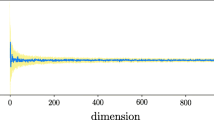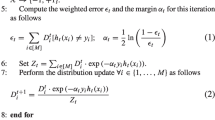Abstract
In classical machine learning, a set of weak classifiers can be adaptively combined for improving the overall performance, a technique called adaptive boosting (or AdaBoost). However, constructing a combined classifier for a large data set is typically resource consuming. Here we propose a quantum extension of AdaBoost, demonstrating a quantum algorithm that can output the optimal strong classifier with a quadratic speedup in the number of queries of the weak classifiers. Our results also include a generalization of the standard AdaBoost to the cases where the output of each classifier may be probabilistic. We prove that the query complexity of the non-deterministic classifiers is the same as those of deterministic classifiers, which may be of independent interest to the classical machine-learning community. Additionally, once the optimal classifier is determined by our quantum algorithm, no quantum resources are further required. This fact may lead to applications on near term quantum devices.
Similar content being viewed by others
References
Y. Freund, and R. E. Schapire, in International Conference on Machine Learning (Margan Kaufmann, San Francisco, 1996).
M. Mohri, A. Rostamizadeh, and A. Talwalkar, Fundations of Machine Learning (The MIT Press, Cambridge, 2012).
K. K. Kong, and K. S. Hong, Pattern Recogn. Lett. 68, 63 (2015).
B. Markoski, Z. Ivanković, L. Ratgeber, P. Pecev, and D. Glušac, Acta Polytech. Hungar. 12, 189 (2015).
E. Owusu, Y. Zhan, and Q. R. Mao, Expert Syst. Appl. 41, 3383 (2014).
Y. L. Jiang, Y. F. Shen, Y. Liu, and W. C. Liu, Math. Prob. Eng. 2015, 1 (2015).
X. Li, L. Wang, and E. Sung, Eng. Appl. Artif. Intel. 21, 785 (2008).
B. P. Roe, H. J. Yang, J. Zhu, Y. Liu, I. Stancu, and G. McGregor, Nuclear Instruments and Methods in Physics Research, Section A: Accelerators, Spectrometers, Detectors and Associated Equipment (Elsevier, Amsterdam, 2005).
C. X. Zhang, and J. S. Zhang, Pattern Recogn. Lett. 29, 1524 (2008).
L. K. Grover, in Proceedings of the Twenty-Eighth Annual ACM Symposium on Theory of Computing, STOC’ 96, Association for Computing Machinery (New York, 1996), pp. 212–219.
A. Y. Kitaev, arXiv: 9511026.
P. W. Shor, SIAM J. Comput. 26, 1484 (1997).
A. W. Harrow, A. Hassidim, and S. Lloyd, Phys. Rev. Lett. 103, 150502 (2009), arXiv: 0811.3171.
A. M. Childs, R. Kothari, and R. D. Somma, SIAM J. Comput. 46, 1920 (2017).
P. J. Coles, S. Eidenbenz, S. Pakin, A. Adedoyin, J. Ambrosiano, P. Anisimov, W. Casper, G. Chennupati, C. Coffrin, H. Djidjev, D. Gunter, S. Karra, N. Lemons, S. Z. Lin, A. Lokhov, A. Malyzhenkov, D. Mascarenas, S. Mniszewski, B. Nadiga, D. OMalley, D. Oyen, L. Prasad, R. Roberts, P. Romero, N. Santhi, N. Sinitsyn, P. Swart, M. Vuffray, J. Wendelberger, B. Yoon, R. Zamora, and W. Zhu, arXiv: 1804.03719.
H. Buhrman, and R. de Wolf, Theor. Comput. Sci. 288, 21 (2002).
J. Biamonte, P. Wittek, N. Pancotti, P. Rebentrost, N. Wiebe, and S. Lloyd, Nature 549, 195 (2017), arXiv: 1611.09347.
C. Ciliberto, M. Herbster, A. D. Ialongo, M. Pontil, A. Rocchetto, S. Severini, and L. Wossnig, Proc. Roy. Soc. A: Math. Phys. Eng. Sci. 474, 20170551 (2018).
X. D. Cai, D. Wu, Z. E. Su, M. C. Chen, X. L. Wang, L. Li, N. L. Liu, C. Y. Lu, and J. W. Pan, Phys. Rev. Lett. 114, 110504 (2015), arXiv: 1409.7770.
Z. Li, X. Liu, N. Xu, and J. Du, Phys. Rev. Lett. 114, 140504 (2015).
V. Dunjko, J. M. Taylor, and H. J. Briegel, Phys. Rev. Lett. 117, 130501 (2016), arXiv: 1610.08251.
M. Schuld, M. Fingerhuth, and F. Petruccione, Europhy. Lett. 119, 60002 (2017), arXiv: 1703.10793.
P. Rebentrost, M. Mohseni, and S. Lloyd, Phys. Rev. Lett. 113, 130503 (2014), arXiv: 1307.0471.
I. Cong, and L. Duan, New J. Phys. 18, 073011 (2016), arXiv: 1510.00113.
S. Lloyd, M. Mohseni, and P. Rebentrost, Nat. Phys. 10, 631 (2014), arXiv: 1307.0401.
M. Sasaki, A. Carlini, and R. Jozsa, Phys. Rev. A 64, 022317 (2001), arXiv: quant-ph/0102020.
J. Bae, and L. C. Kwek, J. Phys. A-Math. Theor. 48, 083001 (2015), arXiv: 1707.02571.
S. Arunachalam, and R. Maity. in Proceedings of the International Conference on Machine Learning, edited by H. Daume, and A. Singh (2020), pp. 9063–9073.
A. Izdebski, and R. De Wolf, arXiv: 2009.08360.
M. Kearns, and L. Valiant, J. ACM 41, 67 (1994).
D. Dervovic, M. Herbster, P. Mountney, S. Severini, N. Usher, and L. Wossnig, arXiv: 1802.08227.
A. W. Harrow, and A. Y. Wei, Proceedings of the Fourteenth Annual ACM-SIAM Symposium on Discrete Algorithms (ACM Press, New York, 2020), pp. 193–212.
H. J. Zhu, R. Kueng, M. Grassl, and D. Gross, arXiv: 1609.08172.
Y. X. Du, M.-H. Hsieh, T. L. Liu, and D. C. Tao, arXiv: 1809.06056.
Author information
Authors and Affiliations
Corresponding authors
Additional information
This work was supported by the Natural Science Foundation of Guangdong Province (Grant No. 2017B030308003), the Key R&D Program of Guangdong Province (Grant No. 2018B030326001), the Science, Technology and Innovation Commission of Shenzhen Municipality (Grant Nos. JCYJ20170412152620376, JCYJ20170817105046702, and KYTDPT20181011104202253), the National Natural Science Foundation of China (Grant Nos. 11875160, and U1801661), the Economy, Trade and Information Commission of Shenzhen Municipality (Grant No. 201901161512), and Guangdong Provincial Key Laboratory (Grant No. 2019B121203002). We sincerely thank Dr. Srinivasan Arunachalam and Mr. Reevu Maity for their helpful discussions.
Rights and permissions
About this article
Cite this article
Wang, X., Ma, Y., Hsieh, MH. et al. Quantum speedup in adaptive boosting of binary classification. Sci. China Phys. Mech. Astron. 64, 220311 (2021). https://doi.org/10.1007/s11433-020-1638-5
Received:
Accepted:
Published:
DOI: https://doi.org/10.1007/s11433-020-1638-5




